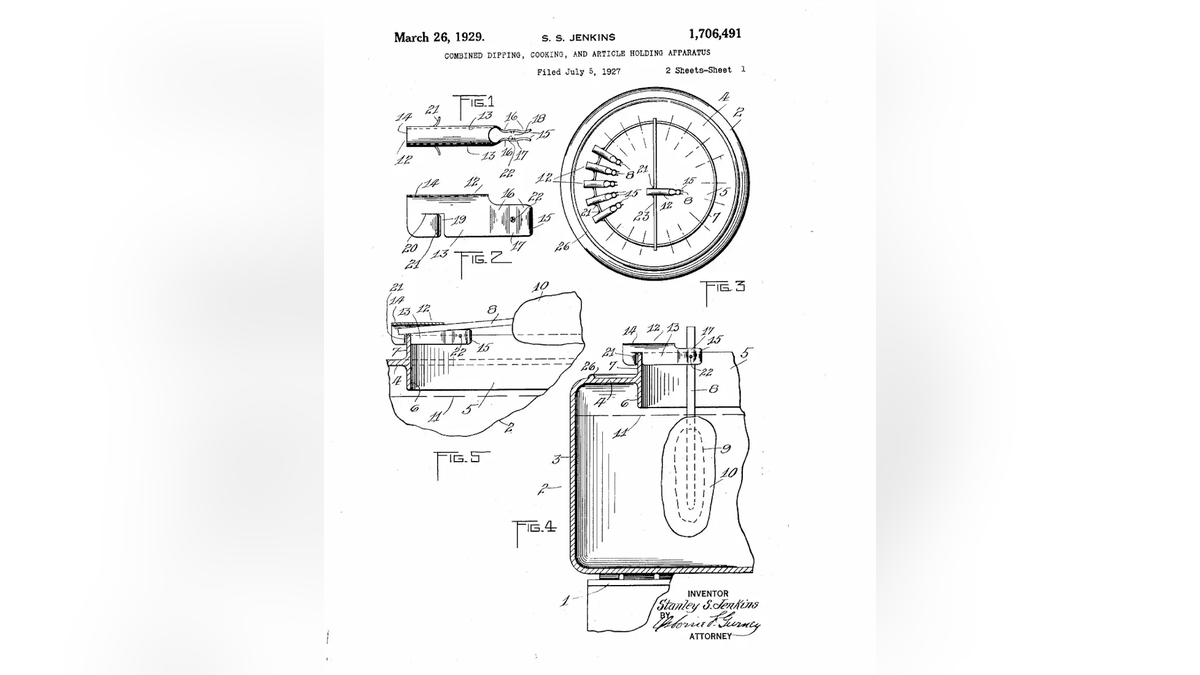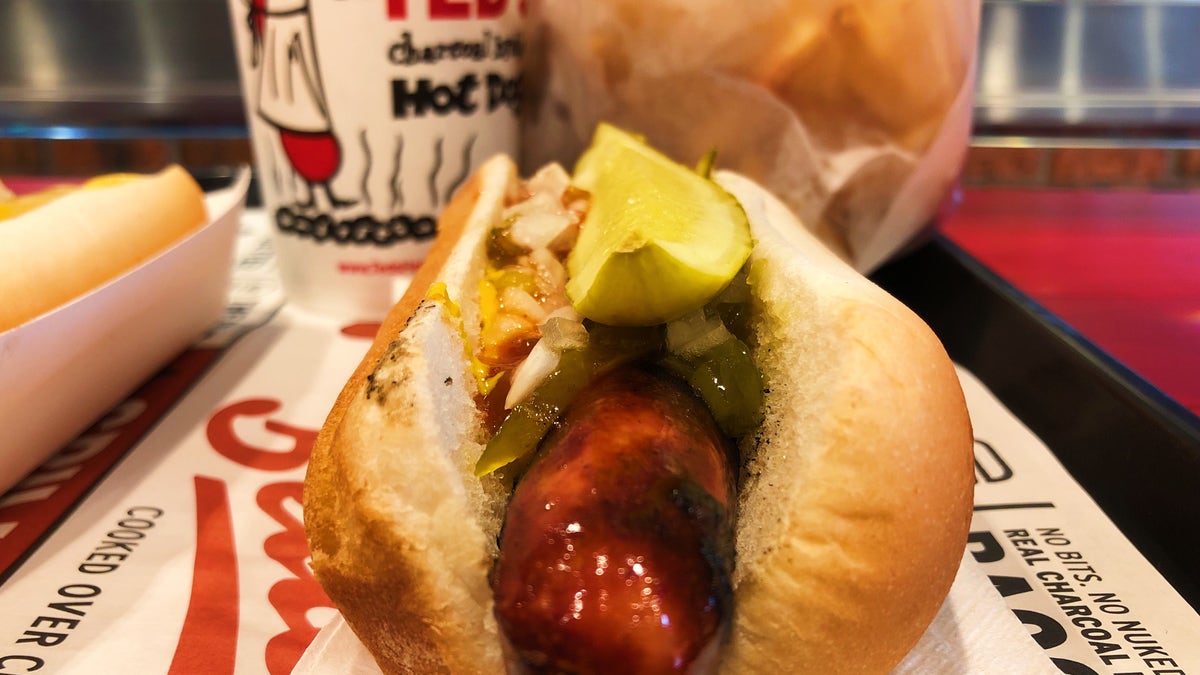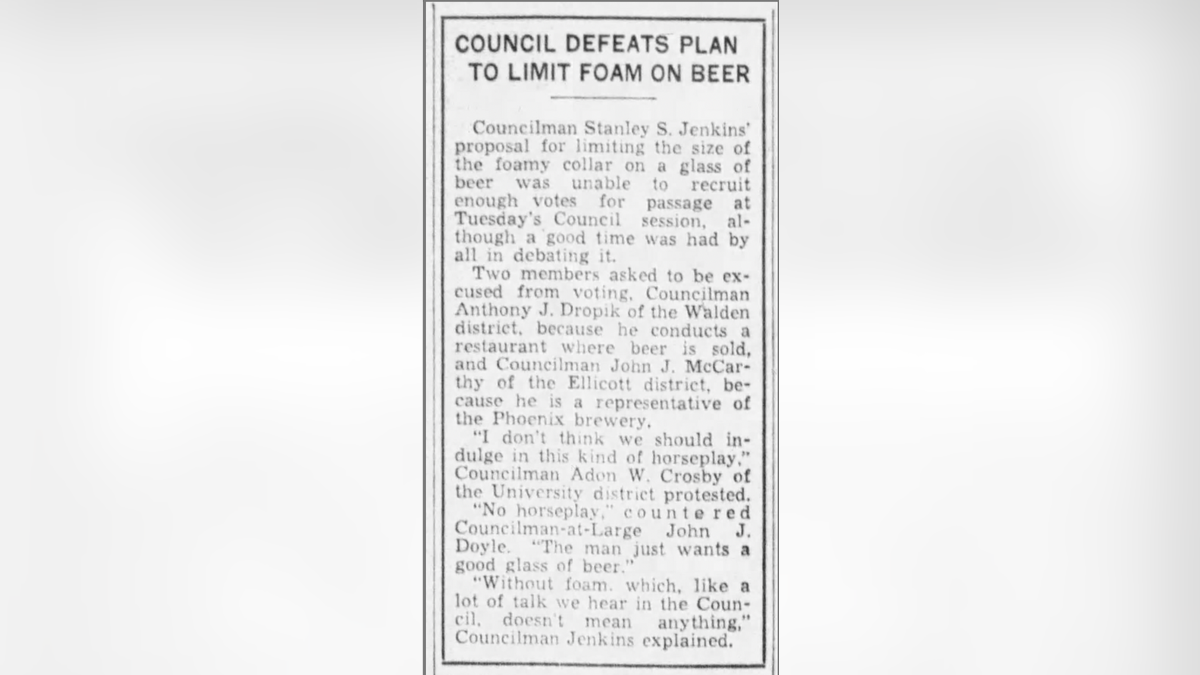Meet the American who brought us the delicious corn dog
Stanley Jenkins of New York created the staple of scores of state fairs across America.
Hail Stanley S. Jenkins, the king of state fair fare.
The businessman, civic leader and part-time inventor from Buffalo, N.Y. imagined — and then defined in poetic detail — the all-American corn dog in 1927.
He pioneered a brave new wiener world in which hot dogs are coddled lovingly in delicious corn-meal batter then bathed in hot oil, a treatment befitting culinary royalty.
Jenkins’ dream of a finer fankfurter soon spread across the nation. Corn dogs today are enjoyed by millions of Americans each year at street festivals, carnivals and state fairs from coast to coast.
MEET THE AMERICAN WHO INVENTED THE DONUT
Fletcher’s Original Corny Dogs sells up to 600,000 corn-meal encrusted wieners each autumn at the State Fair of Texas in Dallas, said third-generation corn dog queen Amber Fletcher, to cite one notable example of its popularity.
Jenkins (1884-1967), the baron of battered bliss, audaciously defended his heart attack on a stick. He called his concept for deep-fried, emulsified tube meat "clean" and "wholesome."

Stanley S. Jenkins, a businessman and civic leader from Buffalo, is credited with inventing the all-American corn dog. He patented a machine in the 1920s that allowed him to skewer and deep-fry battered hot dogs and other foods. His idea soon spawned an American culinary phenomenon. (The Buffalo History Museum)
This champion of the American appetite channeled his profound genius for the public good. He served on the city council of Buffalo, where he heroically fought for the rights of Joe Six-Pack and "a good glass of beer" — demanding regulations that limited the amount of frothy foam atop a tumbler of suds.
The wiener-and-pint patriot Jenkins is largely forgotten by history. He appeared to leave no wife or children. But he stands astride the nation today as a colossus of American folk food.
'Clean, wholesome, tasty refreshment’
The United States celebrated its 151st birthday on July 4, 1927.
The following day, pigs-in-a-blanket pioneer Stanley S. Jenkins filed an application with the U.S. Patent and Trademark Office for an appliance that allowed him to impale battered foods with "a stick or a handle" and deep-fry them in oil.

Corn dogs are ready to be eaten during the American Meat Institute's annual Hot Dog Lunch in the Rayburn courtyard on July 19, 2017, in Washington, D.C. The hot dog lunch held during National Hot Dog month has been celebrated for decades in Washington. (Joe Raedle/Getty Images)
"I have discovered that articles of food such, for instance, as wieners, boiled ham, hard-boiled eggs, cheese, sliced peaches, pineapples, bananas and like fruit, and cherries, dates, figs, strawberries, etc., when impaled on sticks and dipped in a batter, which includes in its ingredients a self-rising flour, and then deep-fried in a vegetable oil at a temperature of about 390 F., the resultant food product on a stick or a handle is a clean, wholesome and tasty refreshment," Jenkins wrote proudly on his patent application.
MEET THE AMERICAN WHO INVENTED LIGHT BEER
In his toil, he discovered that virtually anything edible could be impaled and deep-fried. His skewered fried-food epiphany, as the patent application notes, was not limited to wieners.

Stanley S. Jenkins, a Buffalo businessman, filed a patent for a machine in 1927 that would cook hot dogs and other foods "when impaled on sticks and dipped in a batter." (U.S. Patent and Trademark Office)
Items like the corn fig never caught on with the American public — the far superior Fig Newton had been introduced back in 1891.
But Jenkins foretold the nation’s state-fair obsession with deep-fried everything by decades. The corn dog was the first to catch the public’s fancy. A whole new category of American casual cuisine had been born.
World War II-era rise of the corn dog
Jenkins received the patent for his contraption in 1929, two years after he filed the application. There is no evidence that he ever produced his patented machine or sold a single corn dog.
But by the early 1940s, as the United States entered World War II, versions of the corn dog just as he had described on his application begin to appear almost simultaneously in far corners of the country — for reasons that remain a mystery even to those in the corn dog community.

Amber Fletcher is the third-generation owner of Fletcher's Original Corny Dogs, which sells 500,000 corn dogs each fall at the Texas State Fair in Dallas. (Thomas Garza/Fletcher's Original Corny Dogs)
Oregon hot dog concessionaires George and Vera Boyington trademarked the name Pronto Pup, their version of the corn dog, and began selling them in 1941 at the Pacific International Livestock Exposition in Portland.
They sold 15,000 Pronto Pups that first year alone, according to the Pronto Pup website. The oddity's success made news even on the East Coast.
Stanley Jenkins stands astride the nation as a colossus of American folk food.
"If you have never heard of Pronto Pups, prepare yourself. They show signs of becoming as ubiquitous as Tom Thumb golf, at least in the West," the Boston-based Christian Science Monitor wrote in 1945.
"[Boyington] impales a 'hot dog' on a stick, dips the 'dog' in the batter, thrusts if for a couple of moments into boiling deep fat, and presto! You have a Pronto Pup."
HOT DOGS: 5 LITTLE-KNOWN FACTS
The Pronto Pup is now most closely associated with the Minnesota State Fair, where more than 25 million have been consumed since 1947, according to Minnesota Public Radio.
"Sometimes an idea is just out there in the air and a lot of people seem to pick it up."
The year after the Boyingtons skewered a helpless battered frankfurter in Oregon, brothers and former vaudeville performers Neil and Carl Fletcher did the same at the State Fair of Texas, apparently unaware of Jenkins' invention or the Oregon Pronto Pup. It's a coincidence few can explain.
"My mom always said that sometimes an idea is just out there in the air and a lot of people seem to pick it up," said Amber Fletcher of her grandfather Neil's invention. "I can’t imagine how somebody in Dallas back then might have heard about it from somebody [like Jenkins] in the Northeast."

Neil and Carl Fletcher began selling corn dogs — or corny dogs, in their parlance — at the State Fair of Texas in 1942. The Fletcher family today sells as many as 600,000 corny dogs at the fair each autumn. (Fletcher's Original Corny Dogs)
State fairs have become laboratories in recent decades for efforts to deep-fry every imaginable food. None have supplanted the corn dog.
"Every year there are new fried-food concoctions, and every year we're the No. 1 seller at the State Fair of Texas," said Fletcher. "We've done it for 80 years with one product that essentially has not changed."
The family company is breaking new ground, however. Its year-old mail-order business will, as of Friday, June 10, have shipped corn dogs to all 50 states for the first time in it 80-year history.
Buffalo: incubator of excellence in casual American cuisine
The corn dog may have proliferated in far-flung corners of the nation.
"Buffalo is to a large degree a little-known food city but one with a really rich culinary heritage."
But the fact that Jenkins first conceived of this all-American delicacy in western New York makes perfect sense to food aficionados who champion Buffalo as a great American center of casual-eats excellence.
"Buffalo is to a large degree a little-known food city but one with a really rich culinary heritage," proclaimed Michael Stern, an author and publisher of Roadfood.com. He's crisscrossed the nation for nearly 50 years chronicling American food culture.
MAC AND CHEESE, AMERICA'S ULTIMATE COMFORT FOOD, GETS A DELICIOUS NEW SPIN
He rattled off a series of delicacies unique to Buffalo in addition to its namesake hot wing: beef on weck, sponge candy and "some of the best chocolatiers on the continent."
It’s also one of the premier hot dog cities in the nation, Stern added.

Ted's Hot Dogs is an "iconic" casual-eats chain in Buffalo famed for its hardwood charcoal grilled wieners. It was founded in 1927, the same year that Buffalo resident Stanley S. Jenkins filed a patent application for a contraption to cook corn dogs. (Visit Buffalo Niagara)
"For anyone who loves great American food, it’s hard to top Buffalo, New York, as a destination," proclaimed Buffalo History Museum spokesman Brian Hayden, author of the upcoming book, "111 Places in Buffalo That You Must Not Miss," slated for a 2023 release.
The city boasts a "robust hot dog culture," he said, while the Visit Buffalo Niagara trade group offers a Hot Dog Trail on its website, claiming that "Buffalo boasts more than 250 years of collective hot dog history."
"Buffalo boasts more than 250 years of collective hot dog history."
Sahlens’ has been selling hot dogs in Buffalo since 1869, said Hayden. In 1927, the same year that Jenkins filed his patent for the corn dog contraption, Greek immigrant Theodore "Ted" Spiro Liaros opened Ted’s Hot Dogs on Buffalo's West Side, near what's now the Peace Bridge to Fort Erie, Ontario.
Hayden said that Ted’s is Buffalo’s "iconic" hot dog chain, celebrated for its charred hardwood-grilled wieners.
It appears that inventor Jenkins toiled on his invention at a time when hot dogs were top of mind in Buffalo culinary culture — nearly 40 years before the Anchor Bar first slathered hot sauce on a chicken wing.
The fight for a good glass of beer
Insight into Jenkins comes from a handful of clippings in local newspaper stories, including an obituary on Sept. 25, 1967, published in the Buffalo Courier-Express.
Jenkins, born in Louisville, Ky., was 83 when he passed away in Buffalo "following an extended illness." He would have been 42 or 43 at the time he filed the patent for his deep-fried food machine.

Children are shown enjoying a corn dog at the Tulsa State Fair in Oklahoma. (Tulsa State Fair )
His patented cooking appliance with its eloquent description of the very first corn dog was not his only invention. Jenkins filed a patent for a "foot grip for invalids" in 1923.
It appears inventing was a hobby. His obituary reports that was the president of the Samson Plaster Board Co. and was "elected councilman-at-large in 1930 and after serving one term was appointed president of the Municipal Civil Service Office of Buffalo in 1934."
He proposed "limiting the size of the foamy collar on a glass of beer" — apparently fearing that too much foam in the glass meant too little delicious golden beer for his constituents.
As a member of the city council, the king of the corn dog attempted to make another stand for everyday Americans.
He proposed "limiting the size of the foamy collar on a glass of beer" — apparently fearing that too much foam in the glass meant too little delicious golden beer for his constituents.

Stanley S. Jenkins, inventor of the corn dog, fought to limit the amount of foam in a glass of beer in 1934 while a member of the Buffalo City Council. (Buffalo Evening News, July 25, 1934)
"I don't think we should engage in this kind of horseplay," said one opponent of the Jenkins anti-foam platform, the Buffalo Evening News reported on July 25, 1934.
"The man just wants a good glass of beer," countered a Jenkins supporter on the city council.
CLICK HERE TO SIGN UP FOR OUR LIFESTYLE NEWSLETTER
His measure was defeated by the council, however — causing Jenkins to lash out with a deeply profound critique of the political classes.
Beer foam, he said, "like a lot of talk we hear in the council, doesn't mean anything," the Buffalo Evening News reported.
CLICK HERE TO GET THE FOX NEWS APP
Jenkins’ obituary lists no wife or children. He was survived only by niece Elizabeth Jenkins and nephew William Jenkins, both of Chicago.
His dream did not die, however. Jenkins' vision of an America bettered by battered deep-fried hot dogs, piping hot on a stick, lives on at every carnival and state fair in the land today.

